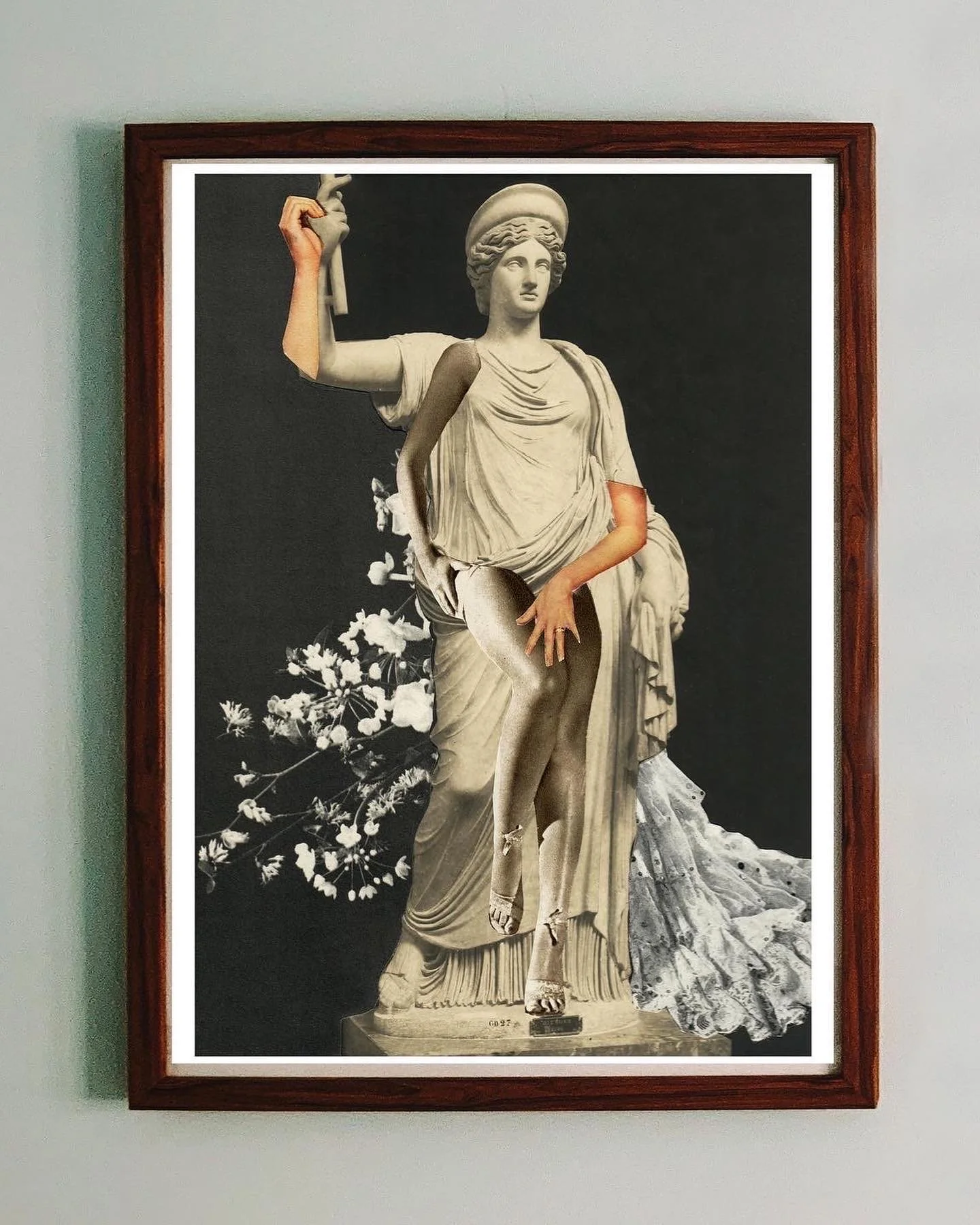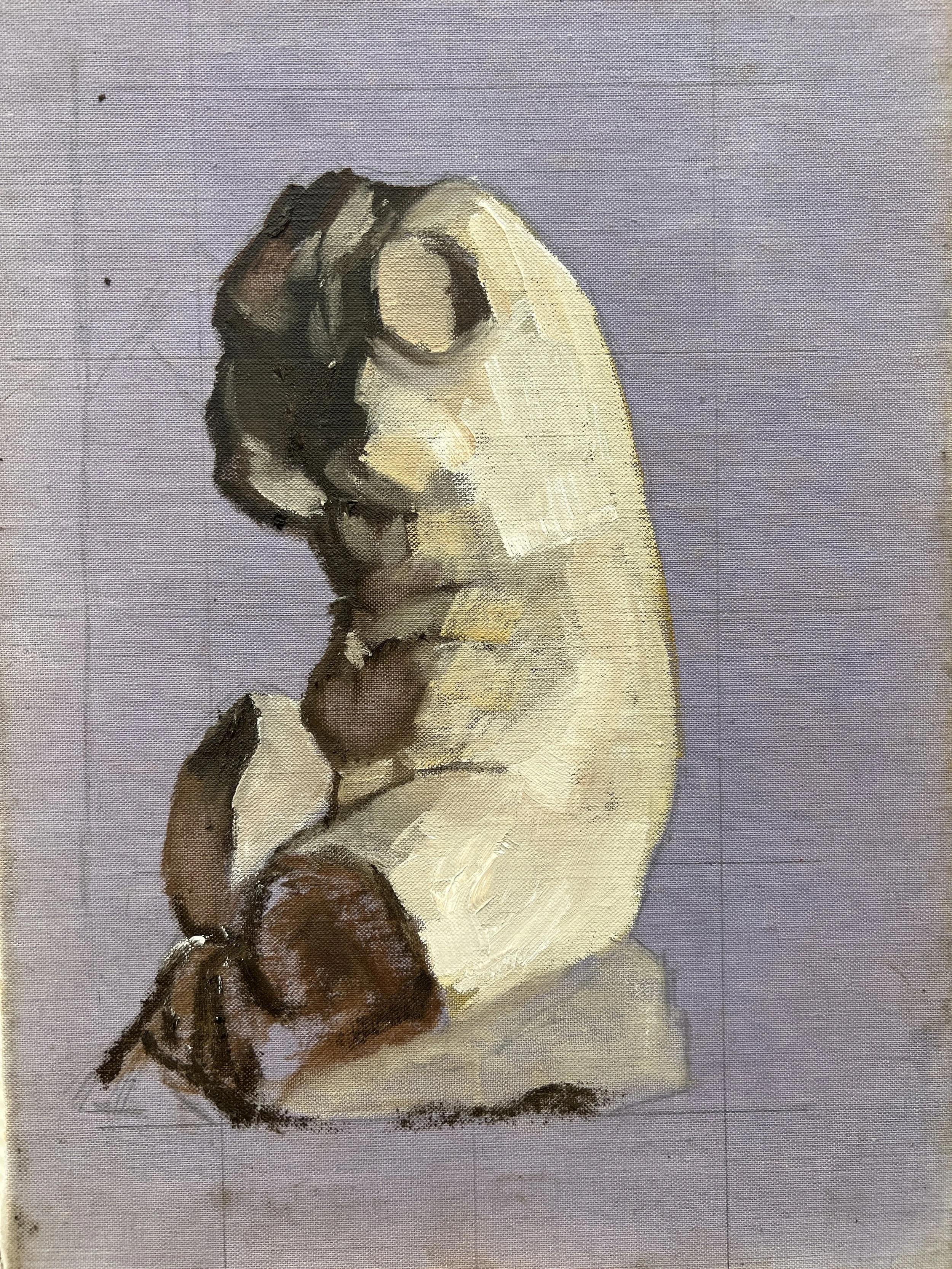Thick skinned and open-hearted, I wish.
I was interested to hear Celia Paul’s description of the artist as thick skinned and open hearted. I have to say I wish I was thicker skinned.
My skin feels porous, too easily osmosing discouragement and a general malaise. It can be difficult in difficult times to justify the time and care spent on art which isn’t about the climate crisis, or the middle east or something monumental and political. The art I want to make is intimate and personal, sometimes it is domestic, sometimes frivolous. Sometimes the art is barely understandable to me, but it wants to be made despite this.
I have spent some time in the summer break overhauling a neglected inventory of my work in the form of a very dry spreadsheet. While the family were hurling themselves down waterslides I was tucked into the shade with my laptop. It was initially a chore I had been putting off but became a surprisingly meaningful exercise as I worked back through each series of collage and painting, noting which have sold, where each piece is, putting down definitive titles and collating dimensions and materials all in one place to save my taxed memory, and appear even partly professional and in control.
The process of cataloging the work has helped clarify for me that the themes I am pursuing are the same themes I was interested in ten years ago. A pair of collages I made in 2017 feel pertinent to my paintings of 2025. Why does this matter? I still really like them, they amuse me, and I think they are beautiful. I want to make more intimate pieces that make me laugh and feel elegant and apposite and beautiful. Collage when it’s good just clicks, it fits into place like a jigsaw puzzle. The pictures make themselves. I’ve only recently begun to make paintings which feel like that regularly. They aren’t a struggle, they just flow out of you, and you almost don’t know when or how it happened.
Some pieces remain a struggle, some paintings or collage are hard work or just don’t work. And at that point it can be useful to stop and think why something isn’t working. But it’s a dangerous game to stop and think, what if the world impinges then, and tells you to give it up, it’s not worth your time? What if you get a rejection just then too? What if someone in your life asks you why you bother if you still have to have a day job? How many pieces have you sold recently? Have you exhibited recently?
A few of those questions oozing through my too thin skin and travelling to my too open heart could knock me down permanently. What IS the point?
Reader, the spreadsheet saved me. That act of cataloguing brought me back in contact with old invoices, comments from kind collectors and reminded me of whole series of collages that have flown the nest to frames and walls in other lives. Perhaps there is a place for intimate, domestic and frivolous little collages, or for paintings that are about painting and not world peace.
Classical Arrangements: Venus in Satin, 2017, 23 x 32cm, also available as limited edition print shop
Cast, after Euan, 2025, 19.5 x 28.5cm, oil on reclaimed book cover
The Clinch
instead of movement, the film stills and publicity photos I most noted where of an enforced stillness. A clinch. A moment when the two lovers (or would be lovers, or even haters who shared some sort of passion) would hover between romance and violence. the moment when the women goes to turn away, or goes to move, to retreat, but is held and surrenders.
Growing up in the 1980’s in a council house in a northern ex-colliery village the first access I had to Hollywood was via a small black and white portable television. This seems impossibly archaic as I tap away to write this on (and admittedly dated) Apple laptop, and I can hear the faint strains of a colliery band cliché-ing away in my minds ear. Stay with me, please. My point is that my access to imagery and the impossibly glamorous, at an early age featured imaginary colour, and was book-ended by local TV reports delivered in flat northern vowels. We only gained a colour tv because someone was giving one away, and the moment we spotted ‘enq. colour TV licence’ written in her beautiful handwriting on our Mam’s shopping list was a moment of high spirits and hilarity. Prompting my sister and I to append such upwardly mobile enquiries as ‘enq. Rolls Royce’ and ‘enq. Horse’. We were way behind the times in terms of taking up a colour TV, and pretty much everyone we knew watched TV in colour. We didn’t mention to our friends that our set was still black and white, and had one of those tiny circular indoor aerials so that when the weather was bad you didn’t get some, or any of the channels at all.
I’ve been consuming visual culture voraciously ever since, so have you, so have we all. And at a faster and more gluttonous rate, since the internet gave us access to more visual information, even than we can stomach.
Sometime in the 2010s, I had a conversation with a friend which would develop into what I came to call The Clinch. She mentioned noticing a behaviour in movies and TV, of a male protagonist manoeuvring or steering his female love interest, tilting her head, moving her torso, turning her cheek towards him. A choreography trope of depicted passion or love I had not noticed. At the time I was making collages from old Hollywood film annuals. I loved the tactility of the vintage print media, particularly when the printing was a little awry. I liked finding double images and overlapping them, exploring composition and playing with those romantic windows the mouth and the eyes. As I flicked through the annuals looking for more collage fodder her comments on this choreography came to mind, and instead of movement, the film stills and publicity photos I most noted where of an enforced stillness. A clinch. A moment when the two lovers (or would be lovers, or even haters who shared some sort of passion) would hover between romance and violence. the moment when the women goes to turn away, or goes to move, to retreat, but is held and surrenders. Sometimes this moment is even proceeded by a “How dare you!?” slap, before the woman eventually succumbs to.. something, passion, or the inevitability of the script.
The Carrot and The Stick, 2020, graphite and gesso on confectionery bags.
The #metoo movement went viral, as did it’s satisfying French equivalent #balancetonporc, in the wake of the Harvey Weinstein scandals later in the 2010s, and I was still collecting clinches, but it seemed to be the right time to start drawing them after seeing a famous gallerist throttle his wife in a restaurant, and see a politician lunge for a woman’s throat in a meeting.
The clinches were so frequent in my cuttings, and in the movies, and had become so overfamiliar.
The Clinch 1, graphite on paper, 30 x 30cm, and The Clinch 2, 2020, graphite powder on dressmakers pattern paper 100 x 150cm, installed in the studio
The clinches were then developed into a toile de jouy inspired wallpaper installation, with hand drawn motifs, vignettes of scenes repeated along it’s length.
Pattern of Behaviour 2019-2023, 75 x 350cm





















